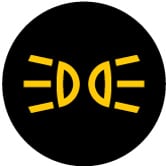Trick-or-treaters won’t be the only ones putting a scare into Albertans this fall. When daylight saving time ends and puts early-evening commuters in the dark, the dangers of deceptive dashboards will also loom large.
Once upon a time, a dim instrument panel served as a visual cue to motorists that their headlights weren’t engaged. But in most new vehicles, the panel is backlit anytime the engine is running. This leads some motorists to assume their daytime running lights (DRL) are also on. Problem is, in many vehicles, DRL doesn’t include taillights.
That means that before sunrise, after sunset and in bad weather, you can come across what are known as “phantom vehicles.” These are cars that are virtually invisible from behind because their rear lights aren’t on.
MORE TO READ
How dashboards contribute to distracted driving
Transport Canada also recognizes phantom vehicles as a safety risk, and recently took steps to address the problem across the country. As of 2021, all new automobiles sold in Canada will be required to be more visible in low-light conditions, by having one of three features:
1) daytime running lights and taillights that turn on when the instrument panel is illuminated and the vehicle is in operation;
2) headlights, taillights and side marker lights that automatically turn on in low-light conditions;
3) an instrument panel that remains dark until the driver manually turns on all the lights.
This isn’t the first time Canada has led the way with regard to vehicle-lighting standards. In 1989, we were the first country in North America to require automatic DRL on all new vehicles, buoyed by research showing that it could reduce crash incidence by up to 15 percent during the day. The irony is that DRL—designed to improve visibility—can inadvertently put drivers at risk, if they believe their full lighting system is engaged by default.
AMA welcomes the federal government’s new vehicle-lighting safety standards, but also understands that cars produced prior to 2021 will be on the road for years to come.
MORE TO READ
Life in the fast lane: Road safety risks in Alberta
So how can you ensure your car is properly lit? Many vehicles have an “auto” option whereby sensors gauge ambient light to switch between DRL and a fully engaged headlight system; just make sure that setting is turned on. Look for an “A,” “Auto” or the DRL symbol on your light dial. For cars lacking an automatic option, keeping your headlights on when driving is the safest bet.
DASHBOARD DECORDER
When these symbols are illuminated, so are various lights on your car*
 Fog lights: Use in low-visibility situations to illuminate the road surface beneath the fog
Fog lights: Use in low-visibility situations to illuminate the road surface beneath the fog
 High beams: Often lit blue; use on dark highways or back roads when no other cars are around
High beams: Often lit blue; use on dark highways or back roads when no other cars are around
 Low beams: Includes rear lights; use before sunrise, after sunset and in low-visibility situations such as heavy rain or snow
Low beams: Includes rear lights; use before sunrise, after sunset and in low-visibility situations such as heavy rain or snow
 Daytime running lights: Unlikely to include taillights; automatically illuminated when the car is running
Daytime running lights: Unlikely to include taillights; automatically illuminated when the car is running
*Check your owner’s manual for specifics about dashboard symbols.
